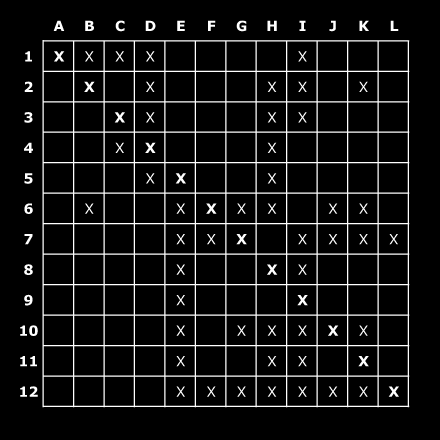The data used for Rebody stems from Bodyscapes, a stage performance, in which the body of the dancer with the help of a motion-tracking apparatus could 'play' the stage as if it was an instrument. This resulted in a number of different, often large, gestures that are easiliy visible when animated.
The audio component of the performance was not used for Rebody.
For Rebody, the data was first visually and then accoustically transformed according to a clearly defined data processing scheme. The sample selection was made during the visual part of the process resulting in 12 separate samples of varying length.
Circ-parameter
The circ-parameter was introduced during the selection of the samples since the data mostly suggested a moving human body. If this suggestion is too strong, figural aspects recede into the background and are less visible. However, given that we were first of all interested in aspects of the figure (and of texture), we needed the circ-parameter in order to transform the data away from clear suggestions of the human body. Thus, in some cases, the circ-parameter helped to 'calibrate' the data in order to heighten figuration. Had the data been different or had we had a longer recording, the circ-parameter may not have been necessary.
A heightend experience of the figural (with or without circ-parameter) was the key criteria for the selection of the samples. Here is a demonstration of sample B with circ=0 and circ=1 respectively. (Rebody uses circ=0.884 for this sample.)
There are moments where sample B, circ=0 is clearly 'walking', a suggestion of the human figure that we wanted to avoid.
At the same time, adding circ to the data also flattens the data, since a point, projected onto a circle, is much less free to move. Rebody makes use of the circ-parameter only in the first few samples, where it helps to introduce the piece.
Jitter
Samples C and particularly D inlcude very visisble (and audible) data artefacts. Those are due to glitches in the motion tracking apparatus, when, for example, not enough cameras were able to see one or more data points resulting is less acurate and thus jumping points.
Those jitters have the most impact when the pelvis was affected, which is the point at which the drawing is 'pinned down' in the centre of the frame. If the pelvis-point jitters, all other points will jitter since they will all move together with the pelvis.
Understanding parameters
After additional parameters for the mapping of the audio were introduced (these parameters did not have an impact on the selection of the samples) and the samples were out into a linear order, Rebody as performance version was basically finished.
However, while Rebody as a whole gives a sense of space in which all of its figures move, in the performance version, it is much more difficult to understand differences within that space due to parameters settings.
In effect, while some parameters only change values that are used in the calculations, others may change the calculations themselves substitioning whole branches of algorithms for others. It is, thus, difficult to assume that algorithmically speaking Rebody presents a single space across is different sample/parameter pairs. In fact, even if we were to look at the dancer's movement before any tracking, at what point might she have switched from one image of the body (say, a walking human) to another one (say, a crawling animal)? If we want to understand figures and textures better, we also have do investigate their particularities beyond them operating in a homogenous 'zone' in which figure and texture are in the foreground. How heterogenous might this 'zone' be?
In order to understand the figures and textures better, we combined all 12 samples with all twelve parameter settings resulting in a two dimensional matrix of 144 sample/parameter combinations. The diagonal of this matrix represents the 'optimal' combinations that we have chosen for the performance version. Other sample/parameter combinations can be experienced in a sample matrix, which will allow for a better understanding of the effect of the parameters as well as for the aesthetic choice that is behind Rebody.
In a final selection process, we reduced the 144 possible sample/parameter combinations to a set of 56, which we consider to be the combinations that 'work', that is, give some form of meaningful output.
The matrix map is displayed on the right. They can be experienced on the page 'Sample Matrix' as well as in Rebody's Installation Version, where all 56 combinations are played one after the other.
